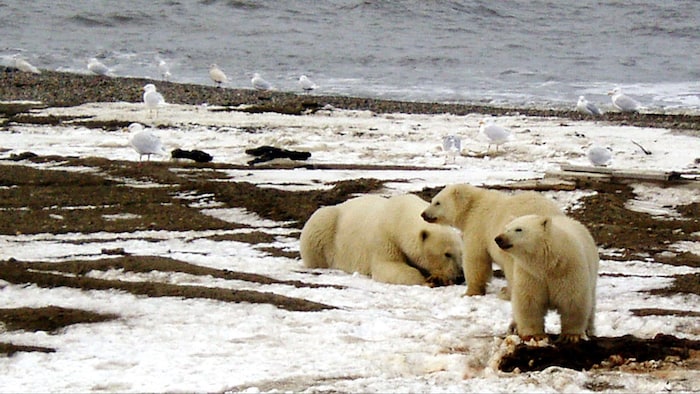Open in full screen mode Polar bears on the coast of the Beaufort Sea, Alaska. Radio-Canada Speech synthesis, based on artificial intelligence, makes it possible to generate spoken text from written text.< /p> The detection of a first case of transmission of the avian flu virus to a polar bear in Alaska has raised concerns about the risk of transmission of avian influenza to other species. The juvenile bear's carcass was discovered by a biologist in the remote North Slope area. Samples taken from the animal confirmed that it had been infected with the highly pathogenic H5N1 strain, according to Alaska State Veterinarian Robert Gerlach. We have detected birds carrying the avian flu virus in the area. So we think the bear wandered onto the land and probably fed on dying or dead birds, and was exposed [to the virus] that way, he said. The surge in cases of H5N1 infection is responsible for the deaths of millions of birds around the world. This strain was first discovered in Canada in 2021. It then spread to poultry farms and to birds of prey and some mammals, according to authorities. Controlling the presence and spread of the virus in Alaska is difficult due to the vast territory, explains Robert Gerlach. When an animal dies, especially in a wilderness like here, it can be eaten quickly by other animals. It's really a challenge to locate these cases, he explains. Certain species in Alaska have been severely affected by the epidemic, such as eagles, magpies and waterfowl, adds the veterinarian. This outbreak of the virus also seems different from the avian flu epidemic of around ten years ago. In this case, we notice that [the virus] persists to remain very active in wild birds, in addition to having an impact on our domestic poultry, says Robert Gerlach. The risk of contamination in humans remains very low, according to him. Cases of human infection with the H5N1 virus are rare, and most often occur after close contact with infected birds or highly contaminated environments such as poultry farms or live bird markets, according to Health Canada. However, it is difficult to predict the evolution of the global epidemic, according to Dr. Gerlach: As this virus adapts and mutates, will it change and create more problems? It's really important that animal health and public health specialists work together to study and understand this virus, so we can be better prepared. Across the border, in Yukon, territorial veterinarian Jane Harms says she is not surprised by the discovery of a case of H5N1 contamination in a polar bear in Alaska, given previously reported cases of transmission of the viruses to other mammals around the world. This transmission from birds to mammals has not really reached the territory until now, says the veterinarian. The last case of contamination, in a wild bird, dates from April 2023. A case was also detected in a red fox a little over a year ago. As in Alaska, case surveillance is complex in this large territory. Wildlife officers most often have to rely on members of the public to report cases of dead or sick animals, says Jane Harms. The main concern of the territory is the transmission of the virus in the wild bird population, but the risk of transmissions between mammals is less clear, according to her. We do not notice a situation where an infected and sick mammal seems to infect another. But it seems that more wild mammals are becoming infected with this strain of avian flu than before. With information from Leonard Linklater and Dave White
First case of bird flu in a polar bear in Alaska

